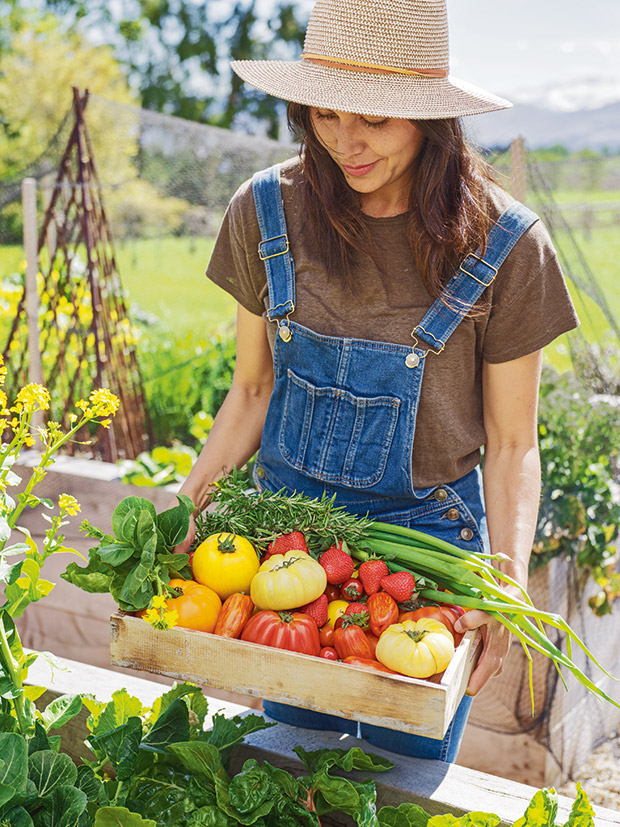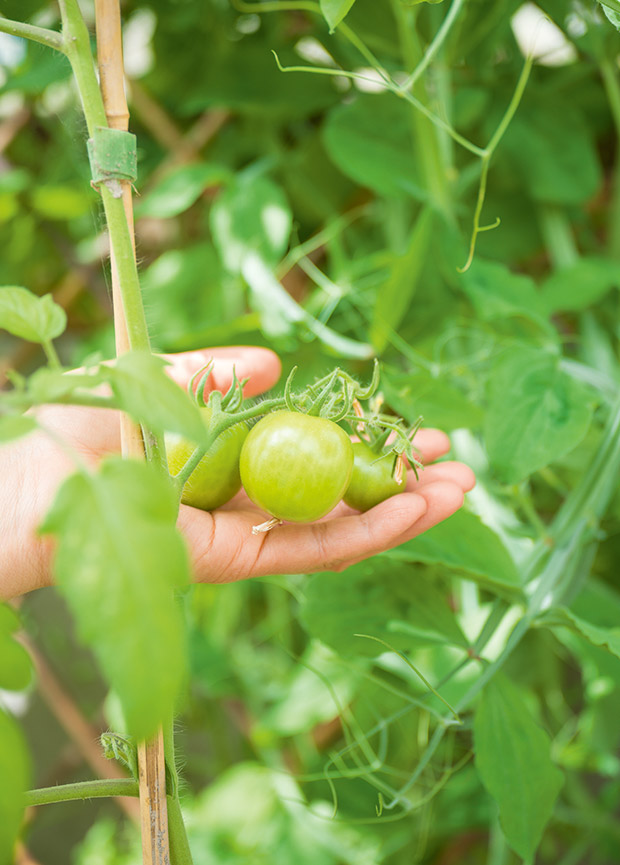Nadia Lim’s guide to growing beautiful tomatoes at home

There’s nothing quite like biting into a homegrown tomato.
Words: Extract from Nadia: A Seasonal Journal Photos: Rachael McKenna
Tomatoes are classified as determinate (bush) or indeterminate (vining). Determinate tomatoes are stocky, short plants that don’t usually require staking and are well-suited to containers or growing in a cage. They develop to a ‘determined’ height and produce flower buds at the end of their growing stem. They have a shorter season, and all the fruit tends to arrive at the same time, but this can be handy in locations with short summers.
‘Roma’ and ‘Scoresby Dwarf’ are two excellent varieties. Most tomato varieties are indeterminate, which means they behave like a vine and need to be propped up with stakes, string or teepees to keep them upright. They’re a lot more productive than determinate tomatoes and can accommodate fruit of different maturity at the same time. They can continue to fruit until late autumn when the conditions become too cold.
– Tomatoes are best grown from transplanted seedlings 11 weeks from transplant to harvest
– Space 50cm apart on the diagonal
– Crop rotation: heavy feeder, requiring soil with lots of nutrients or rich in compost. Rotate/alternate planting space with light feeders
– Plant family: Solanaceae
How to grow beautiful tomatoes
1. Prepare the soil
Tomatoes are heavy feeders, meaning they use lots of nutrients from the soil, so prepare the ground in advance of planting your seedlings and you’ll be on the way to the best crop of tomatoes ever. Incorporate compost or seaweed a few weeks before planting, or dig in sheep pellets or fish meal.
2. Don’t plant out too early
Don’t be too eager to plant out tomato seedlings when spring arrives, especially if you live in a cold area. Tomatoes don’t like the cold and are sensitive to frosts,
so wait until all risk of frost has passed. Traditionally, tomato seedlings are planted on or about Labour Day (late October).
Seeds sown during September should be ready for planting by late October and early November. Sow in pots or trays filled with seed-raising mix and keep in a warm, sheltered spot out of direct sunlight until ready. Tomatoes planted in early summer will produce fruit in autumn.
3. Plant in full sun
When seedlings reach 10cm high, plant outdoors in well-drained soil in full sun or a glasshouse. Space 50cm apart to allow for air movement; too close and plants will be susceptible to disease.
4. Plant deeply
Pinch off the bottom set of leaves from each seedling and bury the roots and stem into prepared garden soil up to the next set of leaves (those furry stems are just waiting to come into contact with the soil to turn into new roots). Plants will form new roots along the buried stems, enabling them to absorb more water and nutrients and be off to the best start.
5. Stake at planting time
Stake or string indeterminate varieties when planting to avoid damaging roots if stakes are inserted later. Determinate varieties typically do not need staking.
6. Feed regularly
Feed plants every two or three weeks with a balanced, water-soluble plant food such as seaweed solution.
7. Water regularly, and consistently
Tomatoes like a regular and consistent watering regime. If soil moisture levels fluctuate too much, the fruit can split or suffer from blossom end rot. It might be worth setting up a basic irrigation system if hand-watering is inconvenient.

8. Remove side shoots
As plants grow, pinch off the laterals (side stems), leaving just a few branches growing from the main stem. This encourages tomatoes to put their energy into fruit development rather than leaf growth. It’s a good idea to remove the lower leaves as plants grow to prevent diseases transferring from the soil onto foliage. Pop these side shoots into the ground, and they will grow
as new plants.
9. Plant prolific producers
For maximum yields, pick tomatoes that are guaranteed to produce. Try ‘Sweet 100’, ‘Sweet Gold’, ‘Gardener’s Delight’ and ‘Gold Nugget’ — all prolific, sweet, cherry tomatoes. Prolific heirlooms include ‘Oxheart’, ‘Watermouth’, ‘Burbank’ and ‘Tangella’. (The latter also has exceptionally high levels of the health-giving tetra-cis-lycopene.) For a modern hybrid, try the medium-sized ‘Soprano F1’ or the meaty ‘Andiamo F1’.
10. Outside the ordinary
There are thousands of weird and wonderful varieties of tomatoes, so try planting something a bit different. This year I’ve grown ‘Black Russian’, ‘Green Zebra’, ‘Broad Ripple Yellow Currant’, ‘Orange Roma’, as well as ‘Watermouth’, ‘Beefsteak’ and heirloom cherry tomatoes.
11. Good companions
I always plant basil with tomatoes. Basil has a strong smell which masks the scent of the tomato plants from pests. Other useful companion plants include marigolds, nasturtiums, spring onions, chives, and coriander. The nasturtiums also draw pests away from tomato plants.
 This article first appeared in Nadia: A Seasonal Journal Magazine.
This article first appeared in Nadia: A Seasonal Journal Magazine.

